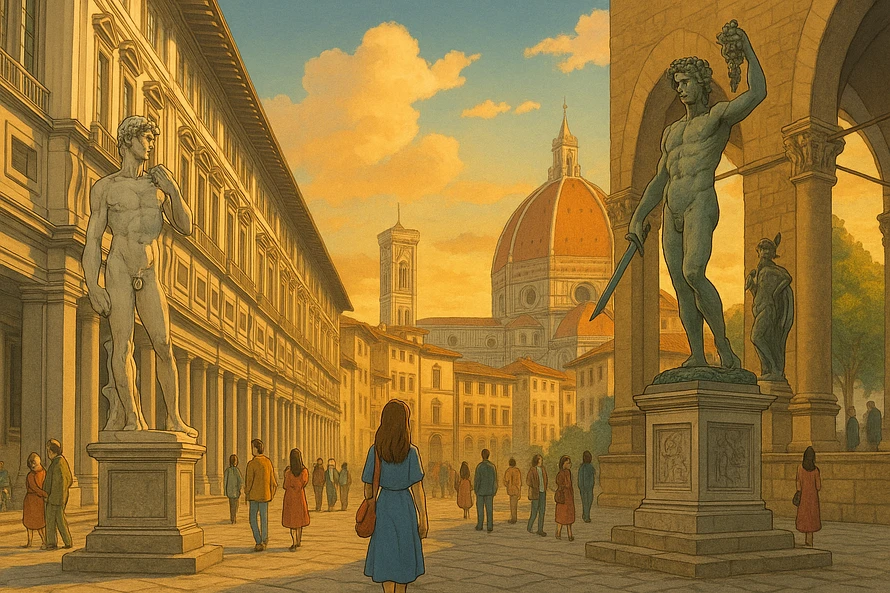Florence: An Immersive Journey Through Museums and Galleries
Florence, the cradle of the Renaissance, is a city that breathes art. Its streets, squares, and buildings are a testament to its rich artistic heritage.
But Florence is not just about its past. It is a vibrant city that continues to celebrate art in all its forms. This experience is for those who wish to immerse themselves in the Florence art scene. It is for those who appreciate the beauty of famous artworks and the stories they tell.
An art lover’s journey through Florence involves more than just ticking off museums. It is about wandering through timeless halls filled with the genius of centuries, about standing face to face with pieces that shaped the course of art history.
From the world-renowned Uffizi Gallery to lesser-known treasures tucked in historic corners, the city offers something for every curious eye.
One cannot begin without walking into the Uffizi Gallery. Housed in a 16th-century building designed by Giorgio Vasari, the Uffizi holds one of the most important collections of Renaissance art in the world.
Botticelli’s Birth of Venus, Michelangelo’s Doni Tondo, and Leonardo da Vinci’s Annunciation are just some of the many masterpieces that grace its rooms.
Caravaggio’s haunting Medusa and the countless self-portraits that line the Vasari Corridor elevate the experience to one of reverent wonder.
A short walk away stands the Accademia Gallery, home to Michelangelo’s David. Towering and luminous in its white marble form, David is not merely a statue but a symbol of Florence’s enduring power.
The fine anatomical precision and emotional intensity of the sculpture make it unforgettable. The gallery also houses Michelangelo’s unfinished Slaves, revealing the hand of the master mid-creation.
Crossing over to the south side of the Arno River leads to the majestic Palazzo Pitti. Once the residence of the Medici family, the palace now houses multiple museums and galleries.
The Palatine Gallery boasts rooms filled with works by Raphael and Titian, framed by gilded ceilings and frescoed walls.
The Royal Apartments give glimpses into the opulence of Medici life, while the vast Boboli Gardens behind the palace open into an open-air museum of sculptures, fountains, and manicured greenery that unfolds with each step.
The Florence Cathedral, or Duomo, is an architectural triumph with its pink and green marble facade and the extraordinary dome engineered by Brunelleschi. Inside, Giorgio Vasari’s fresco of the Last Judgment looms over visitors with vivid imagery.
Climbing to the top provides sweeping views of the city’s terracotta rooftops and winding streets. The Duomo is not only a place of worship but a beacon of Florence’s artistic and architectural ambition.
The Basilica of Santa Croce is where art and history meet. It houses the tombs of Italy’s most venerated figures, including Michelangelo, Galileo, and Machiavelli.
Giotto’s frescoes fill the chapels with scenes from the life of St. Francis, and the Pazzi Chapel stands quietly with Brunelleschi’s signature architectural harmony.
The adjacent museum displays fragments of flood-damaged art, reminding visitors of the city’s ongoing relationship with preservation and loss.
In the Bargello Museum, sculpture takes center stage. Housed in a former barracks and prison, the museum holds Donatello’s David in bronze, a graceful and bold reimagining of the biblical figure.
The collection includes works by Michelangelo and Cellini, along with decorative art and armor that reflect the era’s skilled craftsmanship. The museum feels intimate yet monumental, offering quiet corners to reflect on timeless forms.
Florence also invites discovery beyond its famous halls. The Museo Horne offers a glimpse into Renaissance domestic life through furnishings, paintings, and tapestries.
The Stibbert Museum enchants with its global collection of armor and historical costumes, blending narrative and design.
The Museo Marino Marini, dedicated to the modern sculptor, reveals Florence’s continued engagement with artistic innovation. Museo Novecento brings contemporary Italian works into conversation with the city’s storied past.
No visit would be complete without strolling through the Boboli Gardens. Sculptures emerge from hedged pathways, and fountains play softly beside shaded walkways. The layout echoes classical ideals, offering both grandeur and tranquility.
From there, head toward Piazza della Signoria, where the Loggia dei Lanzi forms an outdoor gallery of mythological and political power.
Perseus with the Head of Medusa by Benvenuto Cellini stands alongside Giambologna’s expressive Rape of the Sabine Women, each sculpture framed by the backdrop of Palazzo Vecchio’s stony defiance.
Above the streets, the Vasari Corridor connects Palazzo Vecchio to Palazzo Pitti, originally designed to allow the Medici a safe passage. The corridor contains hundreds of self-portraits by artists through the ages, a winding artery of creative lineage.
Though access is limited, when open, it offers a glimpse into the personal histories of those who shaped artistic vision.
Florence’s contemporary art scene breathes new life into the city’s historic soul. The Strozzina Center for Contemporary Culture curates exhibitions that reflect global voices, while the Museo Novecento traces the evolution of Italian art in the twentieth century.
Modern installations sit within Renaissance architecture, a dialogue of eras that challenges and inspires.
To truly enjoy the artistic depth of Florence, pace yourself. Choose accommodations close to the historic center for easy access to museums and galleries.
The St. Regis and Four Seasons offer elegance near major sights, while budget-friendly hostels like Academy Hostel or Plus Florence offer charm and convenience.
Walking the city is part of the experience, so wear comfortable shoes, pause for gelato, and allow time to be moved by what you see.
Florence is not simply a place to visit. It is a city that invites you to feel. The brushstrokes of Botticelli, the chisel of Michelangelo, the patronage of the Medici, and the gardens behind a palace are all part of its living canvas.
Whether standing before a masterpiece or watching the Arno flow at sunset, you will carry the spirit of Florence with you long after you leave.
